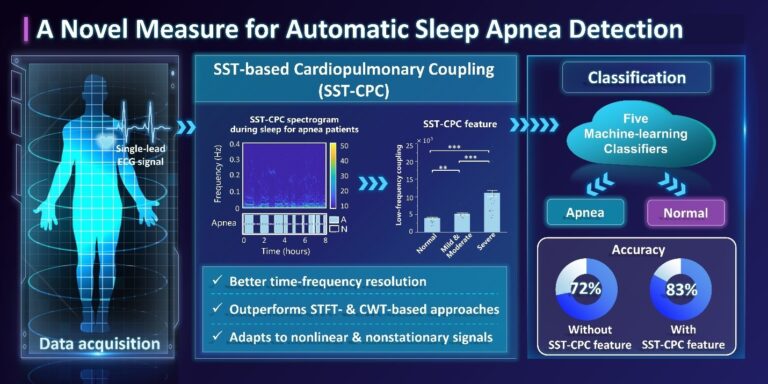In this issue, vol. 27, issue 4, April 2023, 15 papers are published related to the to the topic Sensor Informatics. Please click here to view them, with link in IEEE XPLORE.
A novel measure of cardiopulmonary coupling during sleep based on the synchrosqueezing transform algorithm.
Yining Wang; Wenbin Shi, Member, IEEE; Chien-Hung Yeh*, Senior Member, IEEE
In this paper, a novel measure for automatic sleep apnea detection is proposed by integrating the synchrosqueezing transform (SST) algorithm with the standard cardiopulmonary coupling (CPC) method. Initially, the single-lead ECG signal of individuals during sleep is collected, from which two time series are obtained, namely, the cardiac inter-beat interval (R-R) and the ECG-derived respiration (EDR) signal. Synchrosqueezing transform is then applied to these two physiologic time series to quantify cardiopulmonary dynamics, and the CPC index is further computed to construct sleep spectrograms. Features derived from such spectrogram are used as input to five machine-learning-based classifiers including decision trees, support vector machines, k-nearest neighbors, etc. By using both the simulated data and real ECGs, the feasibility and reliability of the proposed SST-CPC method in automatic respiratory event detection are validated. Furthermore, comparisons to the other two original CPC methods based on short-time Fourier transform (STFT) and continuous Wavelet transform (CWT) are also performed in this paper. The results reveal that the SST-CPC method is robust to both the noise level and signal bandwidth, outperforming Fourier-based and Wavelet-based approaches. Meanwhile, from the sleep spectrograms obtained by the SST-CPC method, it is evident to see that the occurrence of low-frequency coupling is highly consistent with the expert-labeled apnea annotations on a minute-by-minute basis. Furthermore, by integrating SST-CPC features with common-used heart rate and respiratory features, accuracies for per-minute apnea detection improve from 72% to 83%, validating the added value of SST-CPC biomarkers in sleep apnea detection. The proposed SST-CPC method enhances sleep diagnostic capabilities and may serve as a complementary tool to the routine diagnosis of sleep respiratory events.
Twitter Content:
Researchers at @ChienHungYeh2, @sue112358, and @YiningWang01 develop a novel synchrosqueezing-based cardiopulmonary coupling (SST-CPC) measure which accurately detects respiratory events during sleep using single-lead ECG signals.
Researchers at @ChienHungYeh2, @sue112358, and @YiningWang01 demonstrate that the suggested synchrosqueezing-based cardiopulmonary coupling (SST-CPC) method promotes the performance of automatic respiratory event detection during sleep.
Subject-Invariant Deep Neural Networks based on Baseline Correction for EEG Motor Imagery BCI.
Kwak, Youngchul; Kong, Kyeongbo; Song, Woo-Jin; Kim, Seong-Eun.
The Human Activity Radar Challenge: Benchmarking Based on the ‘Radar Signatures of Human Activities’ Dataset From Glasgow University.
Yang, Shufan; Le Kernec, Julien; Romain, Olivier; Fioranelli, Francesco; Cadart, Pierre; Fix, Jeremy; Ren, Chengfang; Manfredi, Giovanni; Letertre, Thierry; Hinostroza Sαenz, Israel; Zhang, Jifa; Liang, Huaiyuan; Wang, Xiangrong; Li, Gang; Chen, Zhaoxi; Liu, Kang; Chen, Xiaolong; Li, Jiefang; Wu, Xing; Chen, Yichang; Jin, Tian.
Wearable-based Assessment of Heart Rate Response to Physical Stressors in Patients After Open-Heart Surgery With Frailty.
Sokas, Daivaras; Eglė Tamulevičiūtė-Prascienė; Aurelija Beigienė; Vitalija Barasaitė; Julius Marozas; Raimondas Kubilius; Raquel Bailón; Andrius Petrėnas.
Block distributed joint temporal-frequency-phase modulation for steady-state visual evoked potential based brain-computer interface with a limited number of frequencies.
Ge, Sheng; Yang, Hui; Wang, Ruimin; Leng, Yue; Iramina, Keiji; Lin, Pan; Wang, Haixian.
Diversity and Suitability of the State-of-the-Art Wearable and Wireless EEG Systems Review.
He, Congying; Chen, Yu-Yi; Stevenson, Cory; Phang, Chun-Ren; Chen, I-Ping; Jung, Tzyy-Ping; Ko, Li-Wei.
LightSeizureNet: A Lightweight Deep Learning Model for Real-Time Epileptic Seizure Detection.
Qiu, Siyuan; Wang, Wenjin; Jiao, Hailong.
Asymmetric effects of different training-testing mismatch types on myoelectric regression via deep learning.
Becman, Eric; DRIEMEIER, LARISSA; Levin, Oron; Swinnen, Stephan; Forner-Cordero, Arturo.
Generalizable Deep Learning-based Sleep Staging Approach for Ambulatory Textile Electrode Headband Recordings.
Rusanen, Matias; Huttunen, Riku; Korkalainen, Henri; Myllymaa, Sami; Tφyrδs, Juha; Myllymaa, Katja; Sigurπardσttir, Sigrνπur; Σlafsdσttir, Kristνn; Leppδnen, Timo; Arnardσttir, Erna; Kainulainen, Samu.
Byte-Pair Encoding for classifying routine clinical electroencephalograms in adults over the lifespan.
Klymenko, Mykola; Doesburg, Sam; Medvedev, George; Ribary, Urs; Xi, Pengcheng; Vakorin, Vasily.
An Indoor Fall Monitoring System: Robust, Multistatic Radar Sensing and Explainable, Feature-Resonated Deep Neural Network.
Shen, Mengqi; Tsui, Kwok-Leung; Nussbaum, Maury; Kim, Sunwook; Lure, Fleming.
Prediction of Serious Intracranial Hypertension from Low-Resolution Neuromonitoring in Traumatic Brain Injury: An Explainable Machine Learning Approach.
Jung, Min-Kyung; Ahn, Daesun; Park, Chan Min; Eun Jin, Ha; Roh, Tae Hoon; You, Nam Kyu; Yoon, Dukyong; Kim, Hakseung; Kim, Se-Hyuk; Kim, Dong-Joo.
A Transfer Learning based Cross-subject Generic Model for Continuous Estimation of Finger Joint Angles from a New User.
Long, Yucheng; Geng, Yanjuan; Dai, Chenyun; Li, Guanglin.
Automatic wheeze segmentation using harmonic-percussive source separation and empirical mode decomposition.
Rocha, Bruno; Pessoa, Diogo; Marques, Alda; de Carvalho, Paulo; Paiva, Rui Pedro.
https://ieeexplore.ieee.org/document/10051156
Variational Phase-Amplitude Coupling Characterizes Signatures of Anterior Cortex under Emotional Processing.
Zhang, Chuting; Yeh, Chien-Hung; Shi, Wenbin.

